The Alpha-1 Antitrypsin Deficiency Market is estimated to be valued at USD 3.8 billion in 2025 and is projected to reach USD 12.7 billion by 2035, registering a compound annual growth rate (CAGR) of 12.8% over the forecast period.
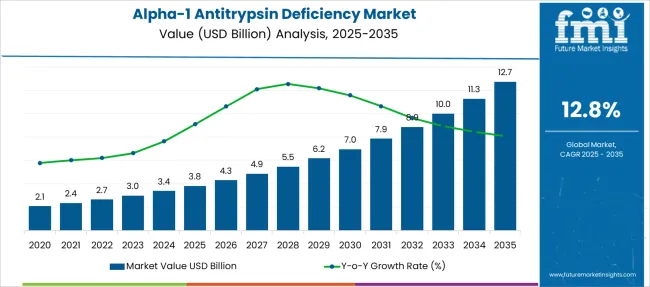
| Metric | Value |
|---|---|
| Alpha-1 Antitrypsin Deficiency Market Estimated Value in (2025 E) | USD 3.8 billion |
| Alpha-1 Antitrypsin Deficiency Market Forecast Value in (2035 F) | USD 12.7 billion |
| Forecast CAGR (2025 to 2035) | 12.8% |
The Alpha-1 Antitrypsin Deficiency market is experiencing consistent expansion, influenced by rising diagnostic awareness, availability of targeted therapies, and increased patient identification through genetic screening programs. Advances in molecular diagnostics and greater integration of rare disease protocols into national healthcare systems are contributing to improved diagnosis rates and access to treatment. Clinical community engagement and initiatives led by healthcare institutions have accelerated early detection, resulting in increased therapeutic interventions.
The market’s future outlook remains positive, supported by sustained research investments, partnerships between biotech firms and academic institutions, and growing emphasis on orphan drug development. Regulatory incentives and reimbursement support in several countries have further encouraged market participation.
Pipeline innovations, alongside an expanding patient registry infrastructure, are likely to support treatment optimization and patient tracking With health authorities reinforcing the need for managing chronic respiratory and liver conditions associated with Alpha-1 Antitrypsin Deficiency, the demand for effective, long-term therapies is projected to remain strong, securing consistent growth across both developed and emerging markets.
The market is segmented by Product Type and Application and region. By Product Type, the market is divided into Augmentation Therapy, Bronchodilators, Corticosteroids, and Oxygen Therapy. In terms of Application, the market is classified into Hospitals, Specialty Clinics, and Pharmacies. Regionally, the market is classified into North America, Latin America, Western Europe, Eastern Europe, Balkan & Baltic Countries, Russia & Belarus, Central Asia, East Asia, South Asia & Pacific, and the Middle East & Africa.
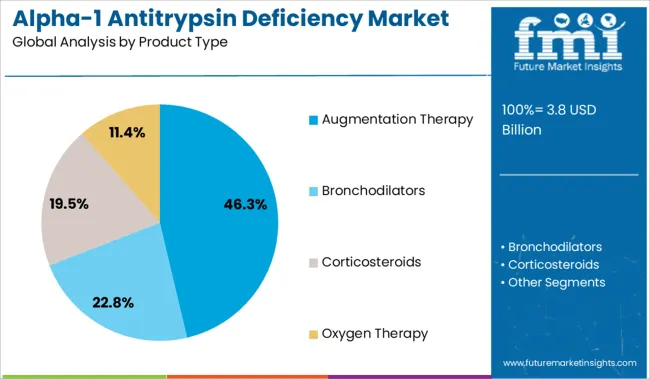
The augmentation therapy segment is projected to account for 46.3% of the Alpha-1 Antitrypsin Deficiency market revenue share in 2025, establishing it as the leading product type segment. This dominance is being driven by the therapy’s proven clinical efficacy in slowing the progression of emphysema in Alpha-1 diagnosed individuals. Augmentation therapy has been widely adopted due to its disease-modifying impact, which is achieved by intravenously infusing purified alpha-1 antitrypsin protein to restore protective levels in the lungs.
Healthcare institutions and specialists have favored this treatment as a standard-of-care approach, reinforced by long-term data from post-market surveillance and clinical studies. The therapy's recognition by regulatory authorities and its inclusion in treatment guidelines have further solidified its relevance.
Additionally, pharmaceutical manufacturers have invested in capacity expansions and supply chain improvements to ensure consistent delivery of augmentation products These factors, combined with increasing diagnosis rates and strong clinical endorsement, have contributed to its leading position within the market.
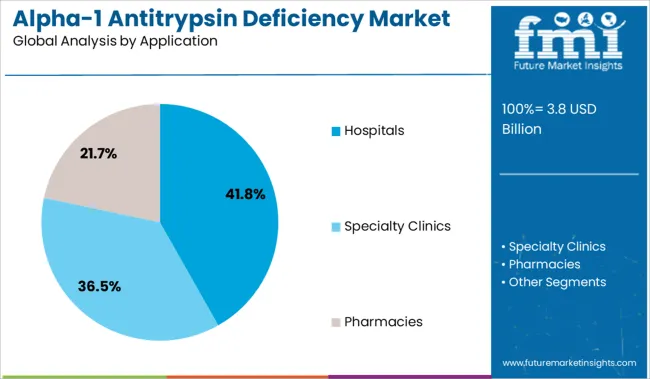
The hospitals segment is expected to contribute 41.8% of the Alpha-1 Antitrypsin Deficiency market revenue share in 2025, making it the largest application segment. This leadership position has been supported by the centralized nature of diagnosis, treatment, and management of Alpha-1 patients within hospital settings. Hospitals have been the primary point of care for intravenous augmentation therapy, diagnostic assessments, and multidisciplinary care for respiratory and hepatic manifestations associated with the condition.
The availability of specialized respiratory and genetic testing infrastructure in hospitals has also facilitated early-stage identification and care continuity. Health systems have increasingly emphasized integrated rare disease management models, where hospitals play a pivotal role in coordinating treatment and patient education.
Furthermore, the segment’s growth has been aided by supportive reimbursement frameworks and public healthcare funding, particularly in North America and Europe These combined factors have reinforced the hospital segment’s dominant contribution to market revenues in 2025.
The global demand for alpha-1 antitrypsin deficiency is projected to increase at a CAGR of 12.8% during the forecast period between 2025 and 2035, reaching a total of USD 12.7 Billion in 2035, according to a report from Future Market Insights (FMI). From 2020 to 2025, sales witnessed significant growth, registering a CAGR of 12.7%.
Numerous technical breakthroughs in diagnostic procedures and the development of novel technologies for the synthesis and purification of AAT. They are of higher grade and devoid of impurities such as viruses and germs. Other factors, such as increased Research and Development efforts and advancements in medical infrastructure, are expected to propel the market even more.
Increasing Research and Development Activities to Accelerate Market Growth
The increasing number of strategic collaborations between public and private market participants is driving an increase in the amount of Research and Development activities on a daily basis. These capabilities are being applied to the creation of innovative pharmaceuticals and medical technologies, which will drive the need for alpha1-antitrypsin deficiency therapy.
Furthermore, an increase in the number of genetic testing, blood tests, and biopsy tests, increased attempts by public and private groups to raise awareness, and a well-organized distribution network of top manufacturers will all contribute to the market's growth rate. Other factors, such as increased demand for effective medicines and expanding use of early diagnostic methods, will have a beneficial impact on the market's growth rate.
Increasing Healthcare Infrastructure Investment
Another key element impacting the growth rate of the alpha1-antitrypsin market is increased healthcare spending, which aids in infrastructure improvement. The expansion and growth of the healthcare business, particularly in developing nations, would encourage the usage and deployment of new and sophisticated medical technology, equipment, and pharmaceuticals. This will immediately boost the need for therapy of alpha1-antitrypsin deficiency.
Huge Investments in Research and Development to Stymie Market Augmentation
High expenses connected with research and development capabilities will emerge as one of the market's most significant limitations. The lack of knowledge and necessary infrastructure in developing and backward nations, as well as sluggish diagnostic rates of alpha1-antitrypsin deficiency, may further derail the market expansion. The slow pace of approval for medications and inhibitors, the scarcity of plasma fractionation capacity, and the rising number of patent expirations will all provide challenges to the market's growth rate.
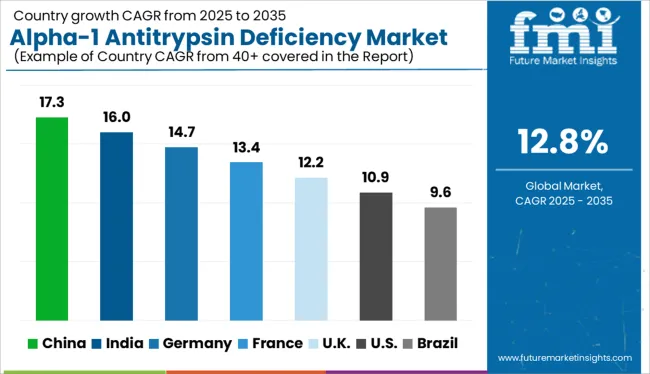
Rising Healthcare Expenditure to Widen Profit Margins
Asia Pacific encompasses nations with a big patient pool and a high elderly population, thus the alpha1-antitrypsin deficiency industry in that region is driven by this factor. Over the projection period, the Asia Pacific regional sector is predicted to increase at a rapid pace.
The constant development of the medical tourism industry, rising healthcare expenditure, and bigger government initiatives pertaining to the development of healthcare infrastructure, primarily biotechnology, agriculture, and pharmacology, are just a few of the factors contributing to the rapid growth of the Asia Pacific alpha1-antitrypsin deficiency market. As per Future Market Insights, the Asia Pacific is expected to grow at a CAGR of 12% in the assessment period 2025 to 2035.
Presence of Established Healthcare Infrastructure to Drive Market
The bulk of the worldwide alpha1-antitrypsin deficiency market was accounted for by North America. Because of the growing number of genetic disease therapeutics clinical trials in the area, North America is ruling the alpha1-antitrypsin deficiency market.
The presence of established healthcare infrastructure in the region, the availability of qualified specialists and advanced genetic testing equipment, high healthcare spending, and superior reimbursement rules are key reasons contributing to its substantial share. North America is expected to grow at a CAGR of 12.7% in the assessment period 2025-2035.
Expanding Patient Pool to fuel Market Growth
Because of the region's abundance of qualified specialists and modern genetic testing equipment, Europe is the second largest market for the alpha1-antitrypsin deficiency industry.
Europe is expected to develop at the fastest rate throughout the projection period owing to an expanding patient pool and more government backing. Thus, owing to the aforementioned reasons, Europe is expected to grow at a CAGR of 12.3% in the assessment period 2025 to 2035.
Corticosteroid-based Treatments are highly sought after
The increased prevalence of chronic illnesses, an aging population, and rising Research and Development spending are the primary drivers of the corticosteroid segment's rise. The worldwide burden of chronic illnesses is expected to rise dramatically in the future years.
Furthermore, the growing senior population is more prone to chronic diseases that necessitate corticosteroid therapy for a number of ailments, which may drive the corticosteroid sector in the coming years further driving the Alpha-1 Antitrypsin Deficiency market.
Hospitals to be Primary Centers for Disbursing Treatments
In terms of application, hospitals led the Alpha-1 Antitrypsin Deficiency market in 2025. Patients mostly desire to be admitted to the hospital for therapy.
Moreover, the availability of highly experienced medical personnel who give a superior treatment experience has contributed to the rising market share over the next several years.
Key start-up players in the automotive axles are offering new and innovative product lines to consolidate their market presence, these aforementioned start-ups have left no stone unturned. Some specific instances of key Alpha-1 Antitrypsin Deficiency start-ups are as follows:
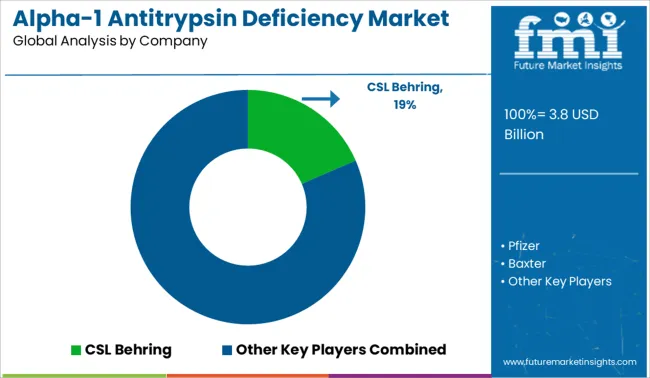
Key players in the Alpha-1 Antitrypsin Deficiency market are Pfizer, Baxter, AstraZeneca, Grifols, Teva Pharmaceutical Industries, Boehringer Ingelheim, Kamada Ltd, GlaxoSmithKline, CSL Behring, and LFB Biomedicaments.
Recent Developments:
| Report Attribute | Details |
|---|---|
| Market Value in 2025 | USD 3.8 billion |
| Market Value in 2035 | USD 12.7 billion |
| Growth Rate | CAGR of 12.8% from 2025 to 2035 |
| Base Year for Estimation | 2025 |
| Historical Data | 2020 to 2025 |
| Forecast Period | 2025 to 2035 |
| Quantitative Units | Revenue in USD Billion and CAGR from 2025 to 2035 |
| Report Coverage | Revenue Forecast, Company Ranking, Competitive Landscape, Growth Factors, Trends, and Pricing Analysis |
| Segments Covered | Product, Application, Region |
| Regions Covered | North America; Latin America; Europe; Asia Pacific; Middle East and Africa (MEA) |
| Key Countries Profiled | The USA, Canada, Brazil, Mexico, Germany, The UK, France, Spain, Italy, China, Japan, South Korea, Singapore, Thailand, Indonesia, Australia, New Zealand, GCC, South Africa, Israel |
| Key Companies Profiled | Pfizer; Baxter; AstraZeneca; Grifols; Teva Pharmaceutical Industries; Boehringer Ingelheim; Kamada Ltd; GlaxoSmithKline; CSL Behring; LFB Biomedicaments |
| Customization | Available Upon Request |
The global alpha-1 antitrypsin deficiency market is estimated to be valued at USD 3.8 billion in 2025.
The market size for the alpha-1 antitrypsin deficiency market is projected to reach USD 12.7 billion by 2035.
The alpha-1 antitrypsin deficiency market is expected to grow at a 12.8% CAGR between 2025 and 2035.
The key product types in alpha-1 antitrypsin deficiency market are augmentation therapy, bronchodilators, corticosteroids and oxygen therapy.
In terms of application, hospitals segment to command 41.8% share in the alpha-1 antitrypsin deficiency market in 2025.






Full Research Suite comprises of:
Market outlook & trends analysis
Interviews & case studies
Strategic recommendations
Vendor profiles & capabilities analysis
5-year forecasts
8 regions and 60+ country-level data splits
Market segment data splits
12 months of continuous data updates
DELIVERED AS:
PDF EXCEL ONLINE
CARD9 Deficiency Treatment Market
Thyroid Deficiency Treatment Market
Vitamin D Deficiency Treatment Market
Human Immunodeficiency Virus Type 1 (HIV 1) Market Size and Share Forecast Outlook 2025 to 2035
Cerebral Folate Deficiency Market
Leukocyte Adhesion Deficiency Management Market - Innovations & Treatment Trends 2025 to 2035
Molybdenum Cofactor Deficiency Type-A (MoCoD-A) Treatment Market Analysis by Drug Class, Route of Administration, Distribution Channel, and Region through 2025 to 2035

Thank you!
You will receive an email from our Business Development Manager. Please be sure to check your SPAM/JUNK folder too.
Chat With
MaRIA